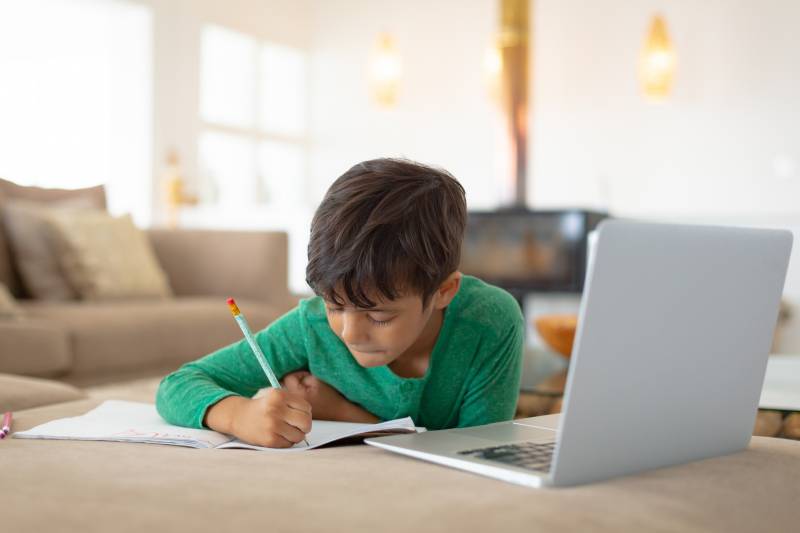2. Know when to pause.
At many schools, teachers jumped online with incredible speed in order to maintain a sense of normalcy and routine. But taking some time off could have served everyone better in the long run.
“It was kind of amazing how fast the teachers made that turn,” said Laufenberg. “But in retrospect, as I talked with our principal, we both kind of chuckled and agreed that we should have taken a couple of days off from instruction to retool and to pause and to breathe and to just enter that space with a little less frenzy.”
3. Examine what kind of skills would be helpful for students who struggled.
A lot of students are missing out on distance learning, but some are thriving at home. Laufenberg says there's an opportunity to teach kids the skills they need to be more self-reliant, which would help with distance learning. For example, when a child’s school schedule is planned to the minute, it might be more difficult for them to learn at home in a situation that requires more self-motivation and self-regulation. This might mean teaching students about time management or how to advocate for yourself when they’re struggling. Some students know how to ask for help online, but for others, it’s too overwhelming.
“They're not sure of themselves. There's not that feedback loop that you can get in person,” said Laufenberg. Students are missing out on the reassurances that keep them plugging away at their work. “So kids question whether or not they're doing it, ‘right’ or ‘right enough’ and get a little anxious about that.”
4. Understand how people self-motivate.
There are a lot of feelings to work through right now for teachers and students. People are grieving over the way things used to be. It’s important to figure out how to be productive while scaling back expectations of teachers and students.
“Just the social and emotional side of what's going on is so overwhelming that a lot of folks kind of start beating themselves up that they're not doing better at it or being efficient enough or effective enough,” said Laufenberg.
She advises teachers that the kind of emergency distance learning few had adequate time to prepare for “is not going to be as good as your classroom. Ever. Breathe that truth in and then let it go. Grieve the loss of that because it hurts. It's not going to be as good; that's a fact. You will make it as good as it possibly can be under the circumstances, under what we are functioning under. But it will not be as effective as what we were doing in school.”
5. Understand that emergency remote distance learning has a shelf life.
Laufenberg said there’s nothing wrong with well-crafted distance learning done by educators who know the pedagogy that goes into online learning.
Many schools are trying to figure out how to make up for lost learning and are looking to extend the current school year into summer break or starting the next school year as early as July. The school district where Laufenberg teaches did the opposite and will end new instruction for middle and high school students three weeks early. She said people understood that the kind of distance learning they were improvising couldn’t continue.
“The general feeling is we can’t keep this thing on the rails and feel good about what we're doing,” she said. “The challenge of trying to meet everybody where they are in all of these very unique scenarios inside their homes — it’s almost impossible for teachers to strike that balance and to meet the needs of everybody.”
6. Starting the school year with testing won’t help.
Schools that assess learning at the beginning of the school year to look for “gaps” in learning will feel brutally unfair and inequitable.
“I would just caution any system that thinks August is for benchmarking their kids to see what they did get. We know what they didn't get,” said Laufenberg. “It really can wait until we get students back into feeling safe and supported at school so that they can learn instead of just fast tracking them back into this track of producing scores.”
7. Get past “falling behind.”
The disruption caused by COVID-19 has many people trying to get back to where they were pre-pandemic. Students and parents are looking for the same schoolwork, grades or experiences needed to keep them “on track,” especially for college admissions, despite the fact that colleges are adjusting their admissions requirements. Laufenberg worries about administrators who pressure teachers to catch students up to a standard that doesn’t take into account the harmful effects of the pandemic and what that could do to kids.
Laufenberg says there are valuable insights to be gained from the scramble to do distance learning. There is time to do things differently next time and better serve students’ needs. The crisis created an opportunity to prove how quickly schools can implement change. Her hope is that schools use this moment to constantly improve and figure out how to do better next time.



